I’ve always been fascinated by the eastern painted turtle (Chrysemys picta picta). These semi-aquatic reptiles are found in eastern North America. They have vibrant red and yellow patterns on their shells, making them a joy to watch.
Eastern painted turtles can be great pets. They bring a piece of nature into your home. Their lively nature and unique adaptations make them interesting companions. Learning about them can deepen your appreciation for nature and the balance of their habitats.
Introduction to Eastern Painted Turtles
The eastern painted turtle is a stunning turtle species found in north american turtles area. It’s a favorite among turtle lovers for its bright colors and toughness. These turtles live in the Chesapeake Bay area and eastern North America, enjoying both rural and urban waters.
They have olive to light tan shells with dark spots. Their front legs have four toes, making them easy to spot.
Natural Distribution and Range
Eastern painted turtles are found from southern Canada to Chihuahua, Mexico. They live in many states and provinces in the U.S. and Canada. They like slow-moving waters, marshes, and ponds with soft bottoms and lots of plants.
Key Physical Characteristics
Adult eastern painted turtles are 4 to 8 inches long. Males are usually smaller than females. Baby turtles are tiny, with shells about 0.9 to 0.94 inches long.
Their shells are olive to light tan with dark spots. Their eggs are 21-36 mm x 15-21 mm, mostly 29-33 x 18-19 mm.
Lifespan and Growth Potential
Eastern painted turtles can live over 50 years in the wild. This shows their long life and growth. They are interesting to study and loved by many turtle fans.
Distinctive Features and Appearance
Eastern painted turtles are known for their bright and unique look. Their shells show a mix of colors that help them hide in their home. The shell’s sides are red, and the belly is a golden yellow.
Their shell patterns earn them the name “painted” turtle. These patterns help them hide from predators. Eastern painted turtles are medium-sized, with shells up to 10 inches long.
There are four types of painted turtles, with the eastern and Midland painted turtles found in North America. They live in wetlands, ponds, and slow waters. This makes them common in many places.
| Characteristic | Description |
|---|---|
| Shell Color | Vibrant red along the sides, with a goldish-yellow belly |
| Shell Size | Carapace lengths typically range from 6 to 8 inches, with some individuals reaching up to 10 inches |
| Subspecies | Eastern painted turtle (Chrysemys picta picta) and Midland painted turtle (Chrysemys picta marginata) |
| Habitat | Wetlands, ponds, and slow-moving waters |
“The unique patterns and markings on the shell of these turtles have inspired their common name, the ‘painted’ turtle.”
Natural Habitat Requirements
Freshwater turtles, like Eastern Painted Turtles, live in different water places. They need certain things to stay healthy and happy.
Water Quality and Temperature
These turtles need clean water. The water should be between 70°F and 95°F (21°C to 35°C). This helps them keep their body temperature right.
Basking Areas and Lighting
Eastern Painted Turtles need places to warm up. They like logs, rocks, or platforms for this. Indoors, they need UVB light for 12 hours a day.
Space Requirements
Adult Eastern Painted Turtles need lots of room. A tank of at least 100 gallons (380 liters) is best. They also need a dry area for resting and basking.
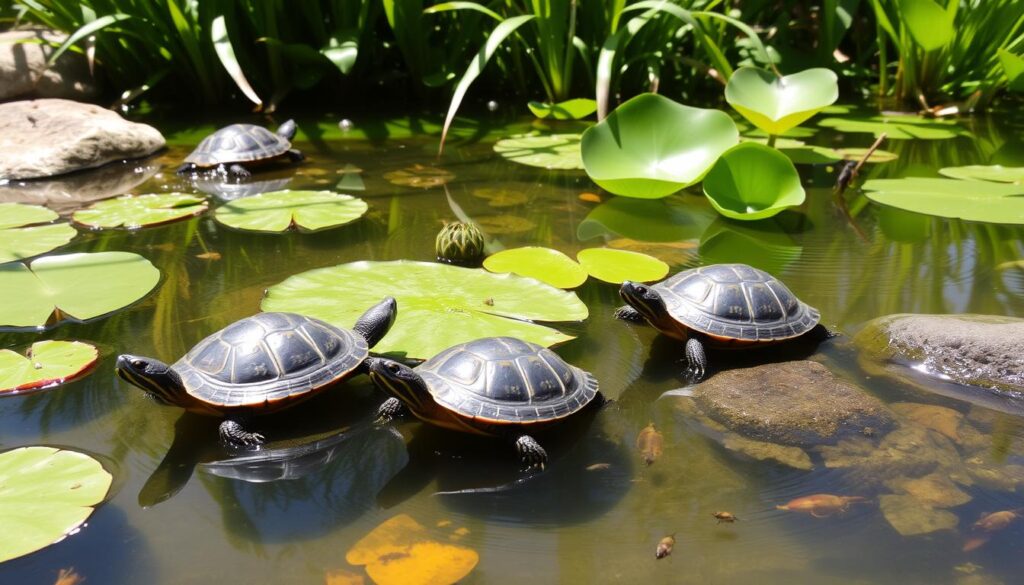
“Turtles have adapted to a remarkable variety of environments, with the greatest number of species occurring in southeastern North America and South Asia.”
Setting Up Your Eastern Painted Turtle Tank
Creating a proper habitat is key for your eastern painted turtle’s health. They need a big tank, at least 100 gallons, with water and a basking area. Use gravel and rocks to make a beach-like spot for basking. A good water filter is also important for clean water and air.
Lighting is vital for your turtle’s health. Make sure the tank has UVB lighting and heat lamps. This helps them stay warm and healthy, just like in the wild. The basking area should be between 85 and 95°F (29 and 35°C).
Adding floating accessories like logs or platforms can give your turtle more places to bask. Also, hiding spots and areas to explore make your turtle feel safe and happy.
| Tank Requirement | Recommendation |
|---|---|
| Tank Size | 100 gallons or more |
| Substrate | Gravel and larger rocks |
| Filtration | High-quality water filter |
| Lighting | UVB lighting and heat lamps |
| Basking Temperature | 85 to 95°F (29 to 35°C) |
| Floating Accessories | Logs, platforms, and hiding spots |
By setting up a well-designed and cared-for habitat, your eastern painted turtle will thrive. They will enjoy a comfortable, natural environment in your care.
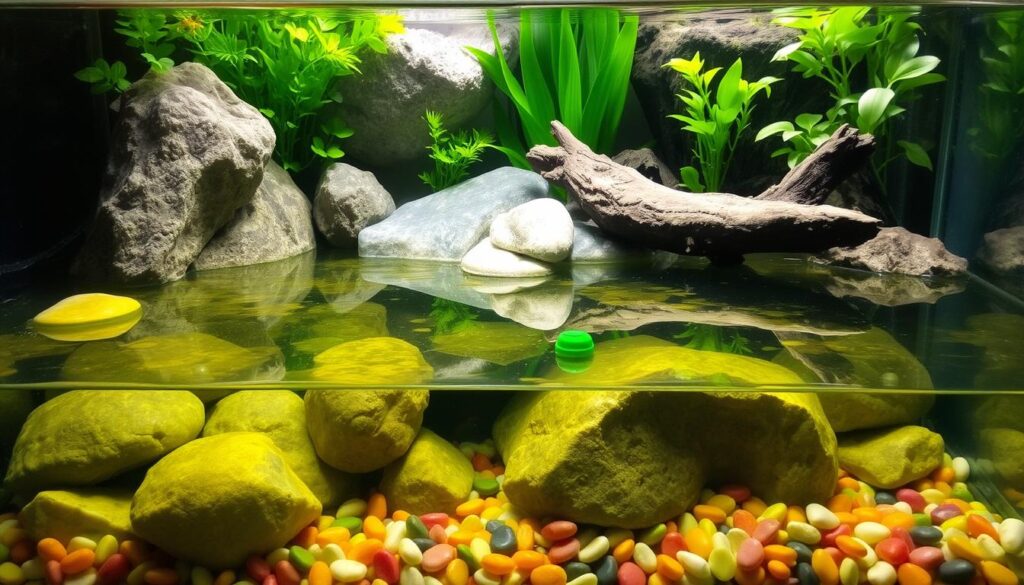
Dietary Needs and Feeding Schedule
Eastern painted turtles eat a mix of commercial pellets, fresh greens, and protein treats. A varied diet is key for their health and happiness. This is important for your freshwater turtles.
Commercial Foods vs. Natural Diet
Start with high-quality turtle pellets as the main food. These pellets have all the nutrients your turtle needs. Add fresh turtle care foods like romaine lettuce and dandelion greens for a balanced diet.
Feeding Frequency and Portions
- Adult turtles need food every other day, adjusting the amount based on their size.
- Give occasional treats like chopped apple and freeze-dried shrimp, but not more than 10% of their diet.
- Hatchlings and young turtles eat more often, needing more protein for growth.
- Too much food can cause health problems like obesity and shell issues, so watch the portions.
Good nutrition and a balanced diet are vital for your eastern painted turtle care. Follow these tips to keep your pet turtle healthy and happy.
| Turtle Age | Feeding Frequency | Dietary Composition |
|---|---|---|
| Hatchling/Juvenile | Daily | Higher protein, such as commercial pellets, insects, and small fish |
| Adult | Every 2-3 days | Balanced mix of commercial pellets, leafy greens, and occasional treats |
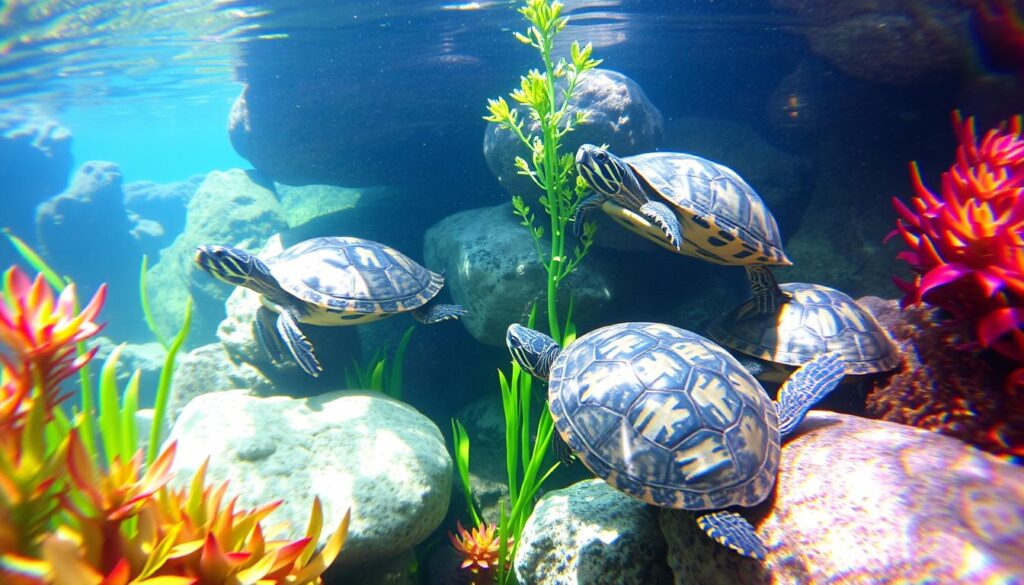
“Proper nutrition and a well-balanced feeding schedule are essential for the long-term health and vitality of your eastern painted turtle.”
Health and Wellness Care
Keeping your eastern painted turtle healthy is key to their happiness. Regular health checks help spot infections or algae on their shell and skin. Clean their shell gently with a soft toothbrush to avoid problems.
Good nutrition is also important to avoid health issues like hypovitaminosis A. Watch the water quality and temperature closely. Also, take your turtle to an exotic vet for annual check-ups and fecal parasite exams.
Common Health Concerns
- Cystic calculi, or bladder stones, often happen because of bad nutrition and not enough water. This causes mineral crystals in the urine.
- Tissue prolapses, like when male turtles’ penis pops out, can be serious. It’s a big problem if it doesn’t go back in easily.
- Irregular shell growth might mean your turtle isn’t eating right or getting enough UV light. This can lead to malnutrition or metabolic bone disease.
- Shell fractures need quick vet care to stop infections or permanent damage. They usually happen from accidents.
- Algae growth on shells means the tank isn’t clean or the water filter isn’t working well. It might need medical help if it gets too bad.
- Salmonella infection is a big risk. It can spread to people, especially kids, the elderly, and those with weak immune systems. So, keeping things clean is very important.
- Dystocia, or egg binding, is a big problem for female turtles. It can happen from bad living conditions, wrong nests, bad diet, or physical blocks. It’s very serious and needs quick action.
Turtles with these health issues might not want to eat, seem tired, have swollen eyes, ear abscesses, kidney failure, or chronic respiratory infections. Quick vet care and the right treatment are vital. They help manage these problems and keep your eastern painted turtle healthy for a long time.
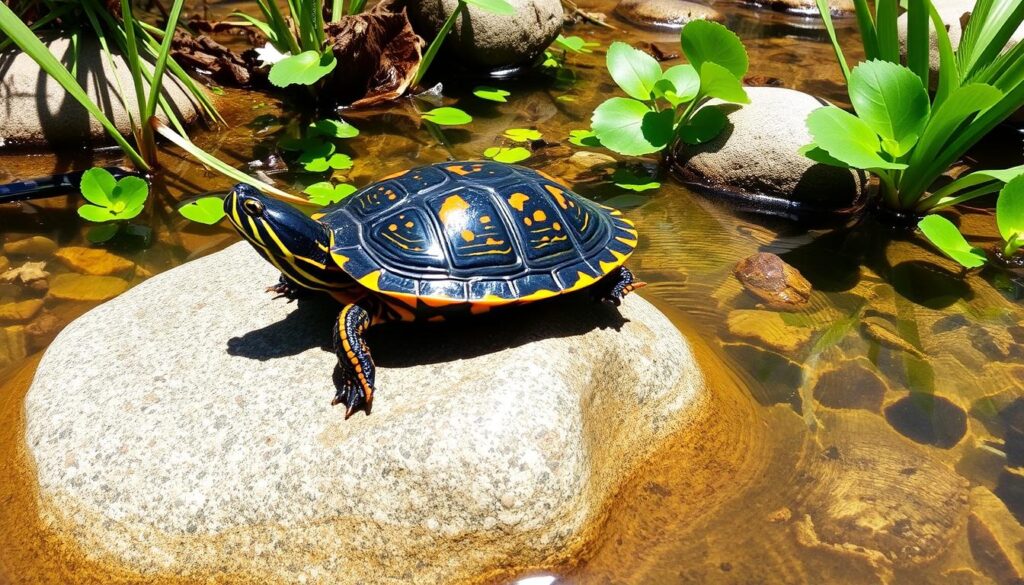
Breeding and Reproduction
Eastern painted turtles are truly captivating. Knowing how they breed and reproduce is key for those who care for them. They usually mate in spring. Females often travel far to find the right place to lay their eggs, sometimes crossing roads.
Mating Behavior
Male eastern painted turtles show off to attract females in spring. They bob their heads, follow the female, and might even bite her. After mating, the female looks for the perfect spot to lay her eggs.
Nesting Requirements
Females like sandy or loamy soil for nesting, with lots of sun. They dig a hole about 4-6 inches deep. They lay 4 to 12 eggs, which incubate for 45 to 75 days, depending on the weather.
Hatchlings face many dangers as they start their journey. It’s important to have the right nesting area for them to grow in captivity.
| Turtle Species | Time to Sexual Maturity | Clutch Size | Incubation Time |
|---|---|---|---|
| False Map Turtle | 2-3 years | N/A | N/A |
| Eastern Mud Turtle | 3-4 years | N/A | N/A |
| Common Snapping Turtle | 10-12 years | 20-30 eggs | 45-75 days |
| Mexican Tortoise | 14-15 years | N/A | N/A |
| Green Sea Turtle | 24-28 years (Florida), 30-34 years (Hawaii), over 40 years (Australia) | 50-90 eggs | 45-75 days |
By learning about eastern painted turtles’ mating and nesting, we can help them thrive in captivity. This knowledge is vital for their well-being.
Common Health Issues and Prevention
Caring for freshwater turtles, like the Eastern Painted Turtle, is a big responsibility. They can get sick if their environment and food aren’t right. Knowing the common problems and how to prevent them helps keep your turtle happy and healthy for a long time.
Parasitic infections are a big problem for freshwater turtles. Roundworms and other parasites can be found in them. Keeping their water clean and feeding them well helps stop these infections.
Shell and skin infections are also common. These infections, or “shell rot,” happen when the water is bad or the tank isn’t cleaned right. Good water quality, the right tank setup, and regular cleaning can help avoid these issues.
- Ear infections: Swollen, discolored ears can be a sign of an underlying health problem and should be addressed promptly by a reptile veterinarian.
- Hypovitaminosis A: Deficiency in vitamin A can lead to symptoms like ear abscesses and puffy eyes, which require targeted nutritional supplementation.
- Metabolic bone disease: This condition, caused by an imbalance of calcium and phosphorus, can result in soft, deformed shells and must be managed through proper lighting and diet.
To keep your turtle healthy, make sure the water is clean, provide the right UVB lighting, and feed them a balanced diet. Watch for signs like being tired, not eating, or shell problems. If you notice anything odd, see a vet who knows about exotic animals.
| Health Concern | Symptoms | Prevention |
|---|---|---|
| Parasitic Infections | Internal parasites, lethargy, loss of appetite | Maintain clean water, provide balanced diet |
| Shell and Skin Infections | Shell abnormalities, discoloration, swelling | Ensure proper water temperature and filtration, clean tank regularly |
| Ear Infections | Swollen, discolored ears | Consult a reptile veterinarian for treatment |
| Hypovitaminosis A | Ear abscesses, puffy eyes | Provide appropriate dietary supplements |
| Metabolic Bone Disease | Soft, deformed shell | Ensure proper lighting and calcium/phosphorus balance in diet |
By knowing and dealing with these health issues, you can keep your turtle happy and healthy for a long time. Taking care of them and getting vet help when needed is crucial for their well-being.
Conservation Status and Legal Considerations
The eastern painted turtle has stable populations but faces many threats. Habitat loss, pollution, road mortality, and illegal pet trade are big challenges. Yet, these turtles are vital for freshwater ecosystems, acting as health indicators.
Wild Population Status
Efforts to protect the eastern painted turtle’s habitats are underway. These include educating people about their importance. By saving their homes in wetlands, lakes, and ponds, we help these colorful turtles survive.
Permits and Regulations
If you want an eastern painted turtle as a pet, check local laws first. Rules on owning these turtles differ by area. It’s key to follow these laws and care for these animals responsibly.
| Turtle Species | Legal Status in the United States |
|---|---|
| Eastern Painted Turtle (Chrysemys picta picta) | Generally legal to own as pets, but regulations may vary by state and local jurisdiction. |
| Common Snapping Turtle (Chelydra serpentina) | Illegal to own as pets in some states due to conservation concerns. |
| Alligator Snapping Turtle (Macrochelys temminckii) | Illegal to own as pets in multiple states due to their size and conservation status. |
| Sea Turtles | Universally illegal to own as pets worldwide due to their endangered status and ecological significance. |
Knowing about the eastern painted turtle’s conservation and legal issues helps us make better choices. By being responsible pet owners and working together, we can protect these amazing turtles. They will continue to thrive in their habitats for many years.
Conclusion
The eastern painted turtle is a captivating freshwater pet. They bring joy and fascination to turtle enthusiasts. Their vibrant colors and interesting behaviors make them great pets.
However, owning an eastern painted turtle is a long-term commitment. They can live for decades with proper care. So, you must be ready for a long-term responsibility.
By providing the right habitat, nutrition, and health monitoring, you can enjoy their company for years. They adapt well to different environments and are peaceful. This makes them perfect for ponds or aquariums.
Whether you’re new to turtles or experienced, this guide has the essential information. It helps you make an informed decision and ensure your pet’s well-being.
As you start your journey with an eastern painted turtle, stay vigilant and prioritize their needs. Cherish the chance to observe and interact with these fascinating creatures. With the right care and dedication, you can build a strong bond and create a comfortable home for your turtle.

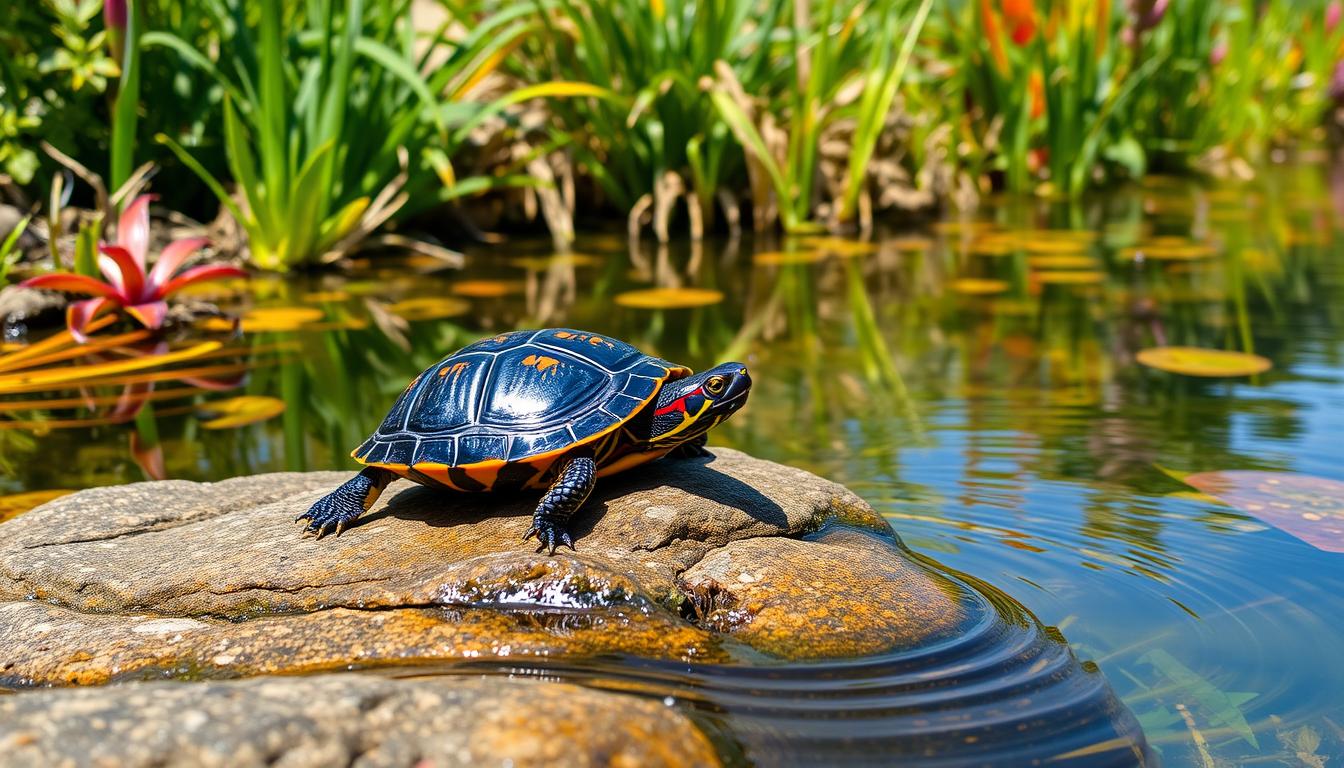
1 thought on “Eastern Painted Turtle: A Colorful Freshwater Pet”